Inequality in Wealth Distribution in Australia: Economic Impact
VerifiedAdded on 2023/06/12
|11
|1815
|63
Report
AI Summary
This report examines wealth inequality in Australia, highlighting its causes, effects, and potential solutions. It discusses the rising gap in wealth distribution and its impact on economic growth, health, and overall well-being. The report identifies factors contributing to inequality, such as wage disparities and ineffective government policies. It also analyzes the Gini coefficient as a measurement tool and explores the consequences of inequality, including stagnant productivity, poor health outcomes, and economic instability. The report concludes by recommending policy reforms to improve education, promote fair employment, enhance healthcare access, and implement effective taxation schemes. Desklib offers a platform for students to access similar solved assignments and study resources.

Running head: INEQUALITY IN WEALTH DISTRIBUTION IN AUSTRALIA
Inequality in Wealth Distribution in Australia
Name of the Student
Name of the University
Author Note
Inequality in Wealth Distribution in Australia
Name of the Student
Name of the University
Author Note
Paraphrase This Document
Need a fresh take? Get an instant paraphrase of this document with our AI Paraphraser
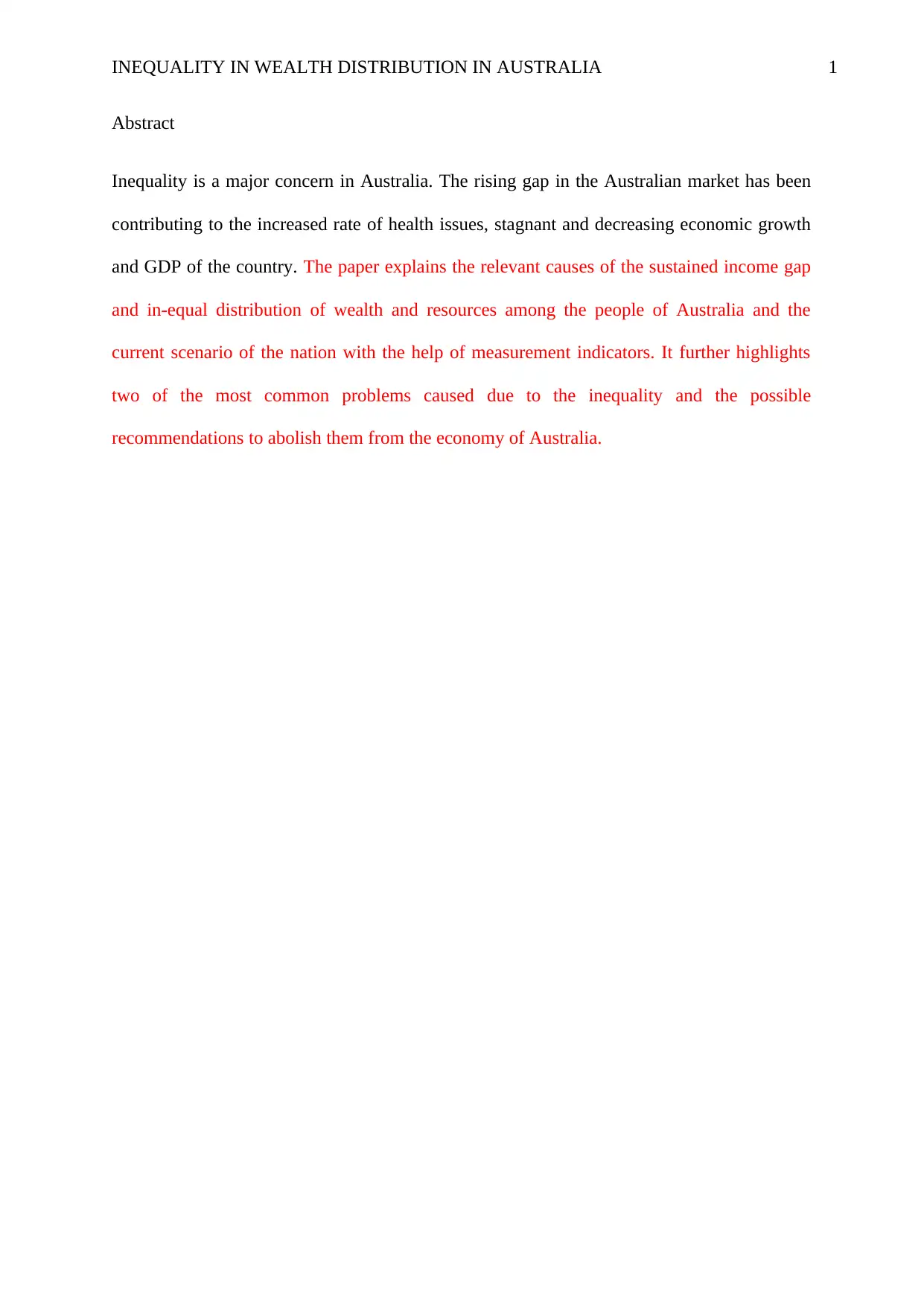
INEQUALITY IN WEALTH DISTRIBUTION IN AUSTRALIA 1
Abstract
Inequality is a major concern in Australia. The rising gap in the Australian market has been
contributing to the increased rate of health issues, stagnant and decreasing economic growth
and GDP of the country. The paper explains the relevant causes of the sustained income gap
and in-equal distribution of wealth and resources among the people of Australia and the
current scenario of the nation with the help of measurement indicators. It further highlights
two of the most common problems caused due to the inequality and the possible
recommendations to abolish them from the economy of Australia.
Abstract
Inequality is a major concern in Australia. The rising gap in the Australian market has been
contributing to the increased rate of health issues, stagnant and decreasing economic growth
and GDP of the country. The paper explains the relevant causes of the sustained income gap
and in-equal distribution of wealth and resources among the people of Australia and the
current scenario of the nation with the help of measurement indicators. It further highlights
two of the most common problems caused due to the inequality and the possible
recommendations to abolish them from the economy of Australia.
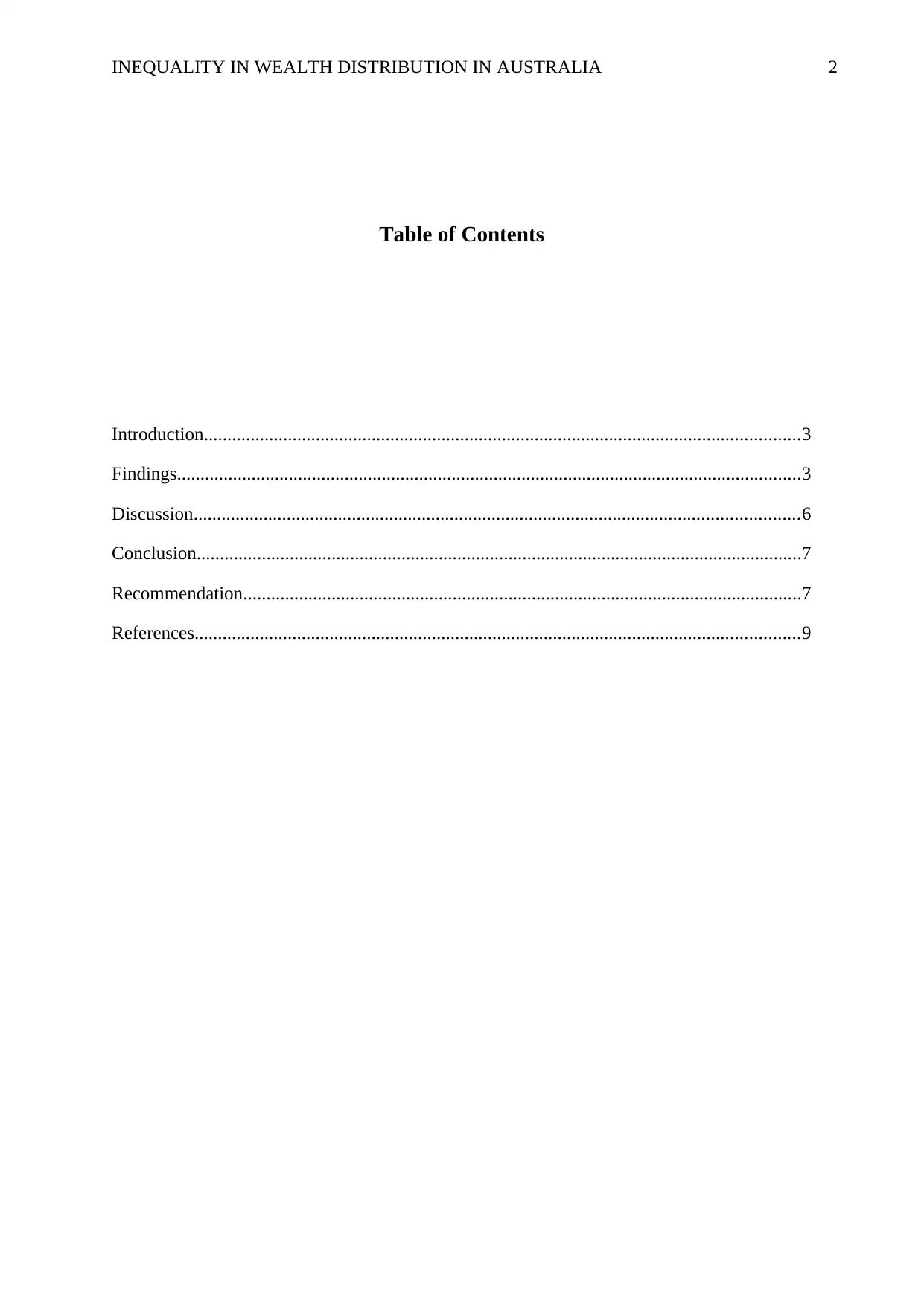
INEQUALITY IN WEALTH DISTRIBUTION IN AUSTRALIA 2
Table of Contents
Introduction................................................................................................................................3
Findings......................................................................................................................................3
Discussion..................................................................................................................................6
Conclusion..................................................................................................................................7
Recommendation........................................................................................................................7
References..................................................................................................................................9
Table of Contents
Introduction................................................................................................................................3
Findings......................................................................................................................................3
Discussion..................................................................................................................................6
Conclusion..................................................................................................................................7
Recommendation........................................................................................................................7
References..................................................................................................................................9
⊘ This is a preview!⊘
Do you want full access?
Subscribe today to unlock all pages.

Trusted by 1+ million students worldwide
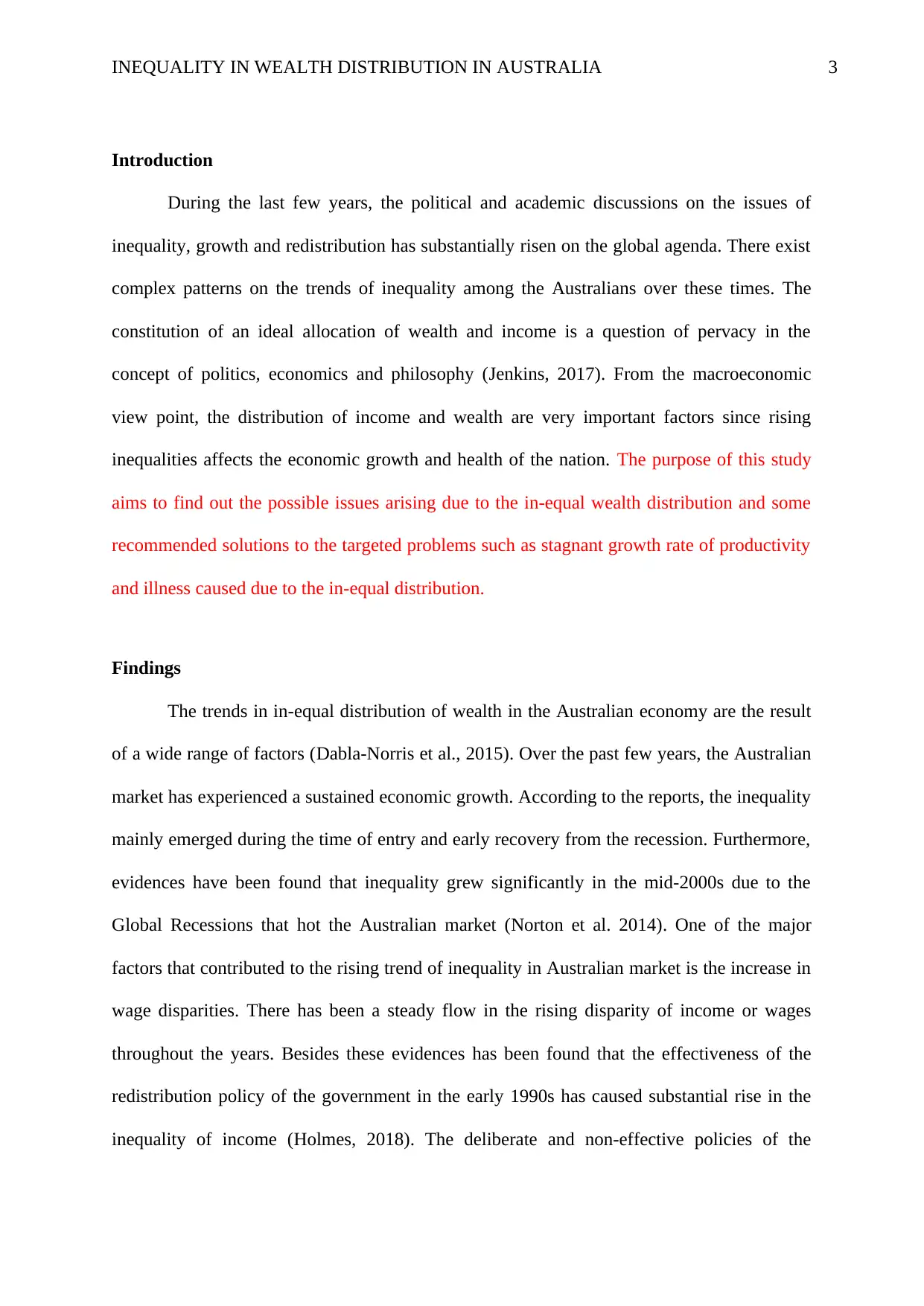
INEQUALITY IN WEALTH DISTRIBUTION IN AUSTRALIA 3
Introduction
During the last few years, the political and academic discussions on the issues of
inequality, growth and redistribution has substantially risen on the global agenda. There exist
complex patterns on the trends of inequality among the Australians over these times. The
constitution of an ideal allocation of wealth and income is a question of pervacy in the
concept of politics, economics and philosophy (Jenkins, 2017). From the macroeconomic
view point, the distribution of income and wealth are very important factors since rising
inequalities affects the economic growth and health of the nation. The purpose of this study
aims to find out the possible issues arising due to the in-equal wealth distribution and some
recommended solutions to the targeted problems such as stagnant growth rate of productivity
and illness caused due to the in-equal distribution.
Findings
The trends in in-equal distribution of wealth in the Australian economy are the result
of a wide range of factors (Dabla-Norris et al., 2015). Over the past few years, the Australian
market has experienced a sustained economic growth. According to the reports, the inequality
mainly emerged during the time of entry and early recovery from the recession. Furthermore,
evidences have been found that inequality grew significantly in the mid-2000s due to the
Global Recessions that hot the Australian market (Norton et al. 2014). One of the major
factors that contributed to the rising trend of inequality in Australian market is the increase in
wage disparities. There has been a steady flow in the rising disparity of income or wages
throughout the years. Besides these evidences has been found that the effectiveness of the
redistribution policy of the government in the early 1990s has caused substantial rise in the
inequality of income (Holmes, 2018). The deliberate and non-effective policies of the
Introduction
During the last few years, the political and academic discussions on the issues of
inequality, growth and redistribution has substantially risen on the global agenda. There exist
complex patterns on the trends of inequality among the Australians over these times. The
constitution of an ideal allocation of wealth and income is a question of pervacy in the
concept of politics, economics and philosophy (Jenkins, 2017). From the macroeconomic
view point, the distribution of income and wealth are very important factors since rising
inequalities affects the economic growth and health of the nation. The purpose of this study
aims to find out the possible issues arising due to the in-equal wealth distribution and some
recommended solutions to the targeted problems such as stagnant growth rate of productivity
and illness caused due to the in-equal distribution.
Findings
The trends in in-equal distribution of wealth in the Australian economy are the result
of a wide range of factors (Dabla-Norris et al., 2015). Over the past few years, the Australian
market has experienced a sustained economic growth. According to the reports, the inequality
mainly emerged during the time of entry and early recovery from the recession. Furthermore,
evidences have been found that inequality grew significantly in the mid-2000s due to the
Global Recessions that hot the Australian market (Norton et al. 2014). One of the major
factors that contributed to the rising trend of inequality in Australian market is the increase in
wage disparities. There has been a steady flow in the rising disparity of income or wages
throughout the years. Besides these evidences has been found that the effectiveness of the
redistribution policy of the government in the early 1990s has caused substantial rise in the
inequality of income (Holmes, 2018). The deliberate and non-effective policies of the
Paraphrase This Document
Need a fresh take? Get an instant paraphrase of this document with our AI Paraphraser
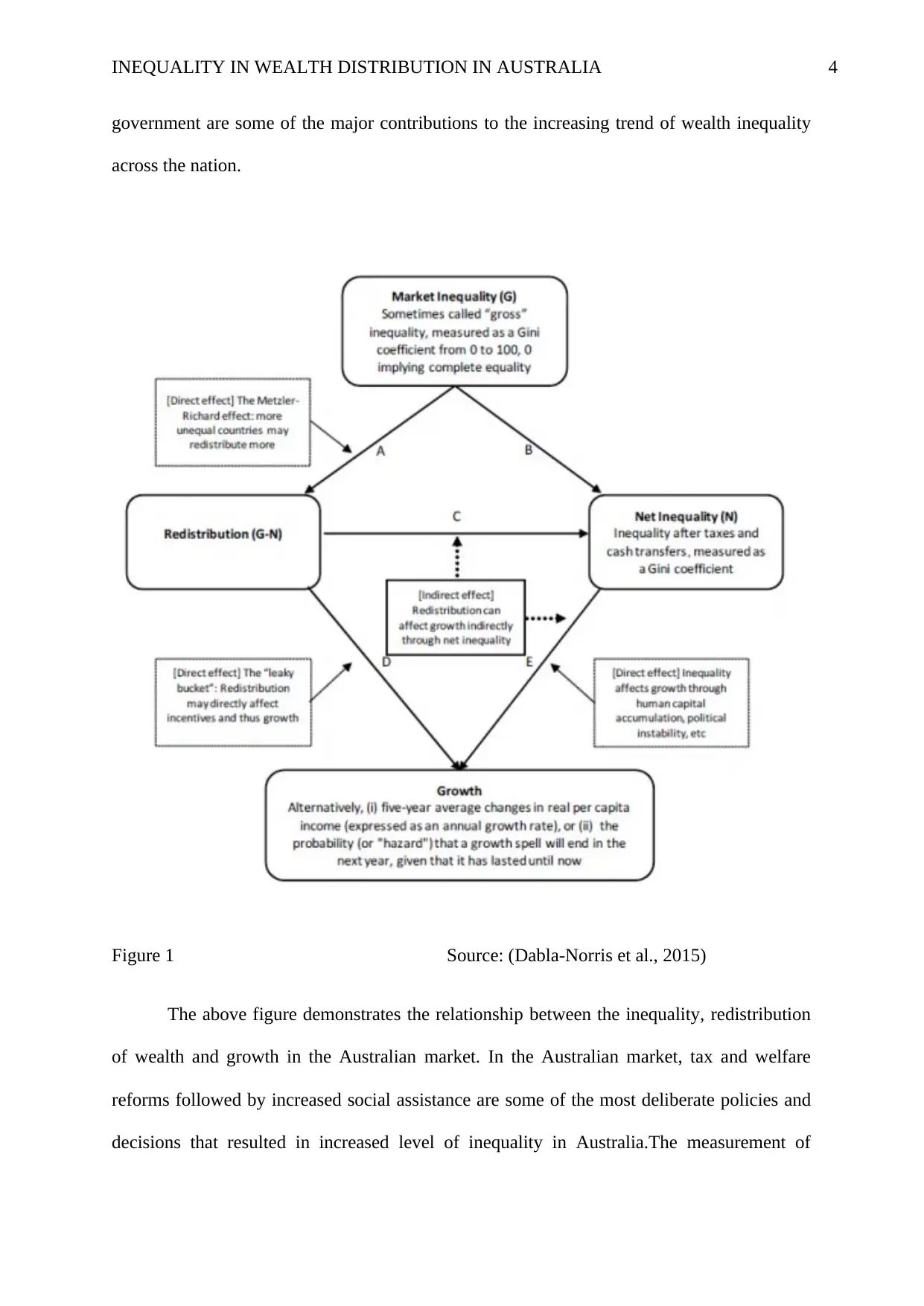
INEQUALITY IN WEALTH DISTRIBUTION IN AUSTRALIA 4
government are some of the major contributions to the increasing trend of wealth inequality
across the nation.
Figure 1 Source: (Dabla-Norris et al., 2015)
The above figure demonstrates the relationship between the inequality, redistribution
of wealth and growth in the Australian market. In the Australian market, tax and welfare
reforms followed by increased social assistance are some of the most deliberate policies and
decisions that resulted in increased level of inequality in Australia.The measurement of
government are some of the major contributions to the increasing trend of wealth inequality
across the nation.
Figure 1 Source: (Dabla-Norris et al., 2015)
The above figure demonstrates the relationship between the inequality, redistribution
of wealth and growth in the Australian market. In the Australian market, tax and welfare
reforms followed by increased social assistance are some of the most deliberate policies and
decisions that resulted in increased level of inequality in Australia.The measurement of
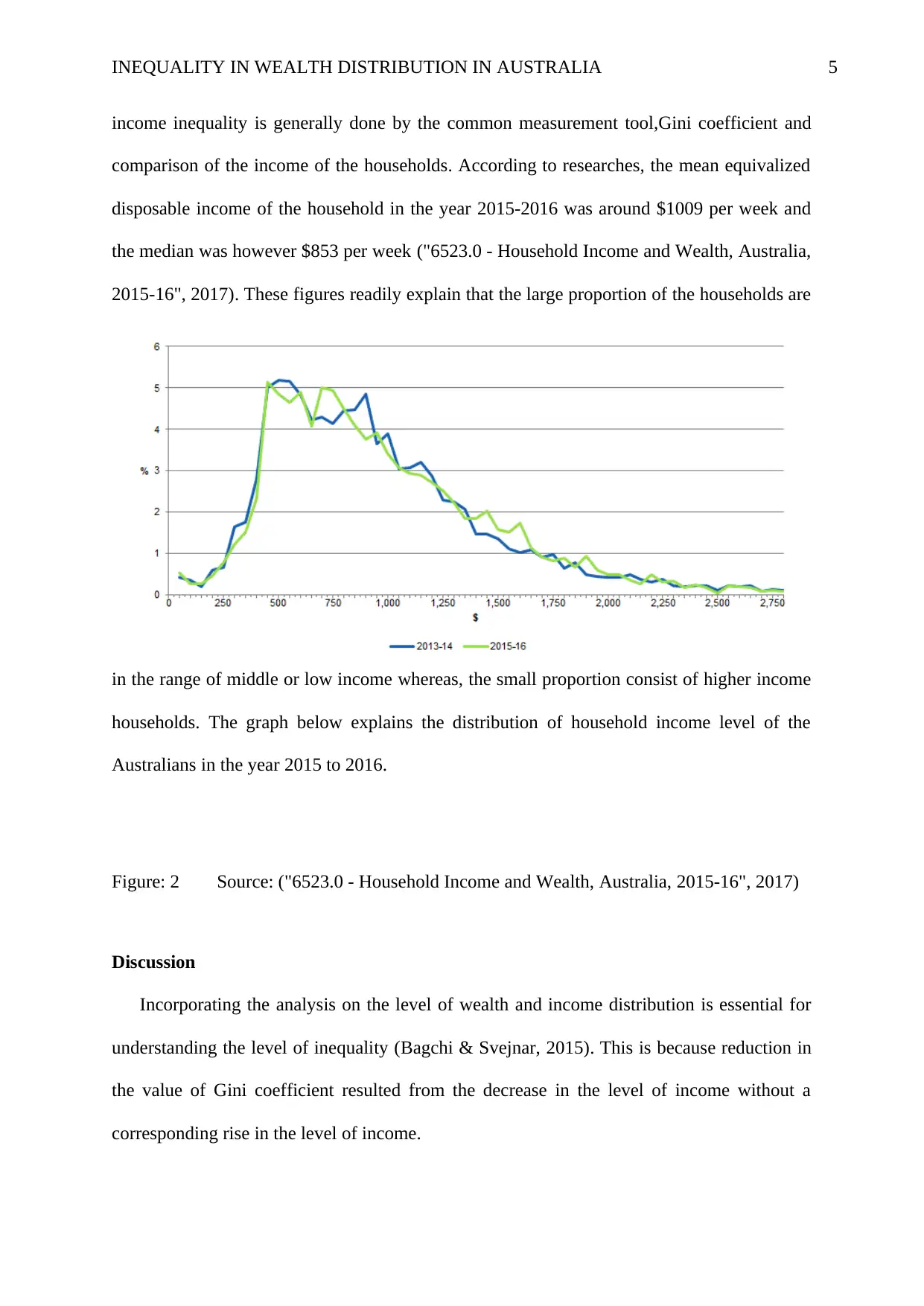
INEQUALITY IN WEALTH DISTRIBUTION IN AUSTRALIA 5
income inequality is generally done by the common measurement tool,Gini coefficient and
comparison of the income of the households. According to researches, the mean equivalized
disposable income of the household in the year 2015-2016 was around $1009 per week and
the median was however $853 per week ("6523.0 - Household Income and Wealth, Australia,
2015-16", 2017). These figures readily explain that the large proportion of the households are
in the range of middle or low income whereas, the small proportion consist of higher income
households. The graph below explains the distribution of household income level of the
Australians in the year 2015 to 2016.
Figure: 2 Source: ("6523.0 - Household Income and Wealth, Australia, 2015-16", 2017)
Discussion
Incorporating the analysis on the level of wealth and income distribution is essential for
understanding the level of inequality (Bagchi & Svejnar, 2015). This is because reduction in
the value of Gini coefficient resulted from the decrease in the level of income without a
corresponding rise in the level of income.
income inequality is generally done by the common measurement tool,Gini coefficient and
comparison of the income of the households. According to researches, the mean equivalized
disposable income of the household in the year 2015-2016 was around $1009 per week and
the median was however $853 per week ("6523.0 - Household Income and Wealth, Australia,
2015-16", 2017). These figures readily explain that the large proportion of the households are
in the range of middle or low income whereas, the small proportion consist of higher income
households. The graph below explains the distribution of household income level of the
Australians in the year 2015 to 2016.
Figure: 2 Source: ("6523.0 - Household Income and Wealth, Australia, 2015-16", 2017)
Discussion
Incorporating the analysis on the level of wealth and income distribution is essential for
understanding the level of inequality (Bagchi & Svejnar, 2015). This is because reduction in
the value of Gini coefficient resulted from the decrease in the level of income without a
corresponding rise in the level of income.
⊘ This is a preview!⊘
Do you want full access?
Subscribe today to unlock all pages.

Trusted by 1+ million students worldwide
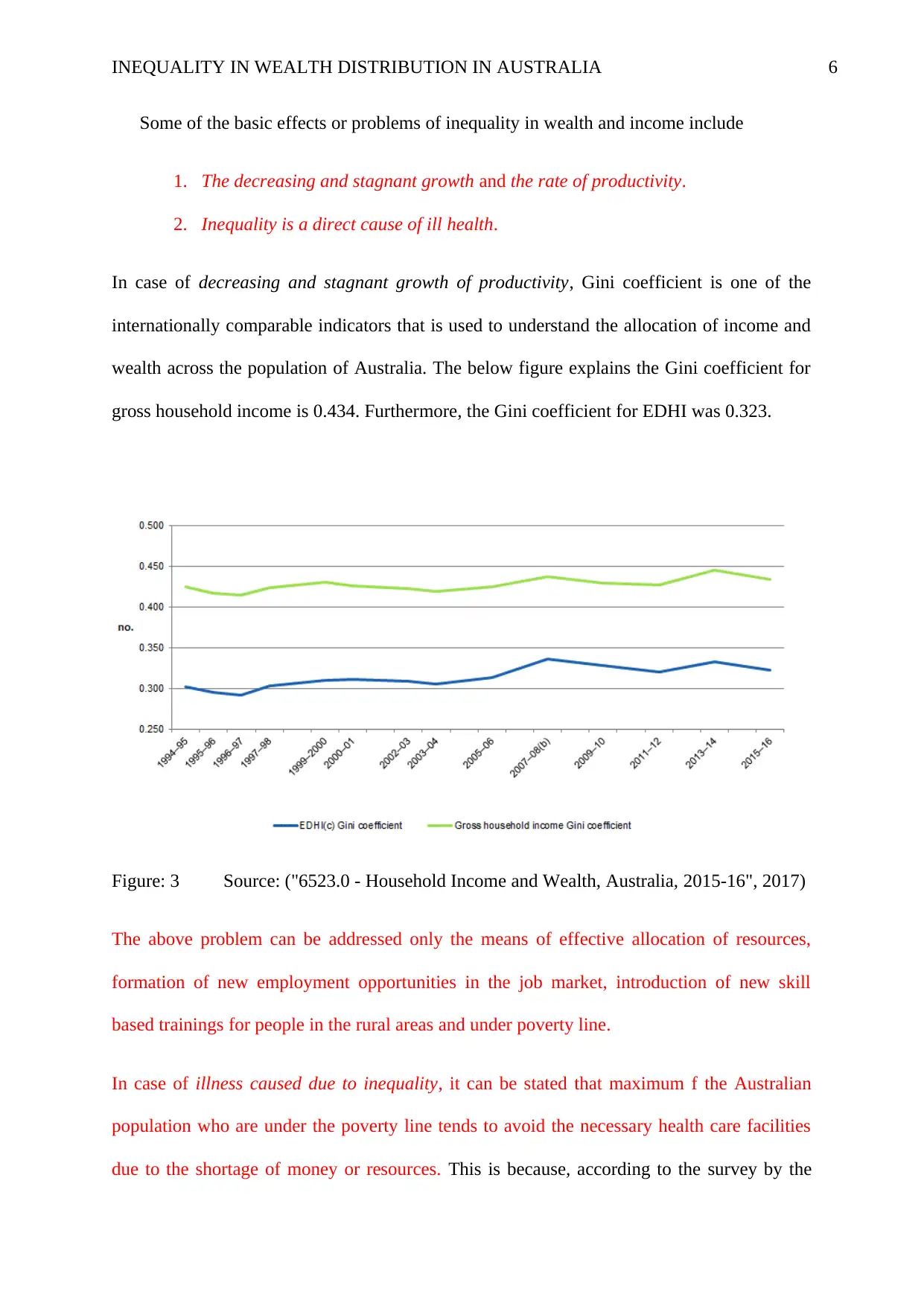
INEQUALITY IN WEALTH DISTRIBUTION IN AUSTRALIA 6
Some of the basic effects or problems of inequality in wealth and income include
1. The decreasing and stagnant growth and the rate of productivity.
2. Inequality is a direct cause of ill health.
In case of decreasing and stagnant growth of productivity, Gini coefficient is one of the
internationally comparable indicators that is used to understand the allocation of income and
wealth across the population of Australia. The below figure explains the Gini coefficient for
gross household income is 0.434. Furthermore, the Gini coefficient for EDHI was 0.323.
Figure: 3 Source: ("6523.0 - Household Income and Wealth, Australia, 2015-16", 2017)
The above problem can be addressed only the means of effective allocation of resources,
formation of new employment opportunities in the job market, introduction of new skill
based trainings for people in the rural areas and under poverty line.
In case of illness caused due to inequality, it can be stated that maximum f the Australian
population who are under the poverty line tends to avoid the necessary health care facilities
due to the shortage of money or resources. This is because, according to the survey by the
Some of the basic effects or problems of inequality in wealth and income include
1. The decreasing and stagnant growth and the rate of productivity.
2. Inequality is a direct cause of ill health.
In case of decreasing and stagnant growth of productivity, Gini coefficient is one of the
internationally comparable indicators that is used to understand the allocation of income and
wealth across the population of Australia. The below figure explains the Gini coefficient for
gross household income is 0.434. Furthermore, the Gini coefficient for EDHI was 0.323.
Figure: 3 Source: ("6523.0 - Household Income and Wealth, Australia, 2015-16", 2017)
The above problem can be addressed only the means of effective allocation of resources,
formation of new employment opportunities in the job market, introduction of new skill
based trainings for people in the rural areas and under poverty line.
In case of illness caused due to inequality, it can be stated that maximum f the Australian
population who are under the poverty line tends to avoid the necessary health care facilities
due to the shortage of money or resources. This is because, according to the survey by the
Paraphrase This Document
Need a fresh take? Get an instant paraphrase of this document with our AI Paraphraser

INEQUALITY IN WEALTH DISTRIBUTION IN AUSTRALIA 7
Australian Bureau of Statistics (ABS), in-equal distribution of wealth and income results into
poor health among majority of Australians (Holmes, 2018). According to the research reports
by the World Health Organization, countries like Australia that tends to have higher level of
in-equal distribution of wealth and income includes people with high stress levels and poor
mental health outcomes (Fletcher & Guttmann, 2013). To summarize, there are many effects
of in-equal wealth distribution in Australia. Some of these are:
Low productivity and decreasing growth of the economy (Fletcher & Guttmann,
2013).
High level of poor health risks
High level of school drop outs and low education level
High economic instability (Jenkins, 2017).
Low development and GDP of Australia
Conclusion
The inequality among those with the least and those with the most has been
substantially increasing in Australia in terms of wealth and income. Though various
provisions, policies and measures has been taken by the government of Australia till date,
much revision and development are needed in the process to abolish the inequality of wealth
and income. It can further be concluded that the tax and transfer system have the ability to
redistribute the nation’s wealth effectively among the people in the nation (Fletcher &
Guttmann, 2013). The extent and the nature of the inequality is basically the choice of the
policy makers and the successive governmental agencies should implement measures to
reduce the inequality and combat the in-equal wealth distribution (Bagchi & Svejnar, 2015).
Australian Bureau of Statistics (ABS), in-equal distribution of wealth and income results into
poor health among majority of Australians (Holmes, 2018). According to the research reports
by the World Health Organization, countries like Australia that tends to have higher level of
in-equal distribution of wealth and income includes people with high stress levels and poor
mental health outcomes (Fletcher & Guttmann, 2013). To summarize, there are many effects
of in-equal wealth distribution in Australia. Some of these are:
Low productivity and decreasing growth of the economy (Fletcher & Guttmann,
2013).
High level of poor health risks
High level of school drop outs and low education level
High economic instability (Jenkins, 2017).
Low development and GDP of Australia
Conclusion
The inequality among those with the least and those with the most has been
substantially increasing in Australia in terms of wealth and income. Though various
provisions, policies and measures has been taken by the government of Australia till date,
much revision and development are needed in the process to abolish the inequality of wealth
and income. It can further be concluded that the tax and transfer system have the ability to
redistribute the nation’s wealth effectively among the people in the nation (Fletcher &
Guttmann, 2013). The extent and the nature of the inequality is basically the choice of the
policy makers and the successive governmental agencies should implement measures to
reduce the inequality and combat the in-equal wealth distribution (Bagchi & Svejnar, 2015).
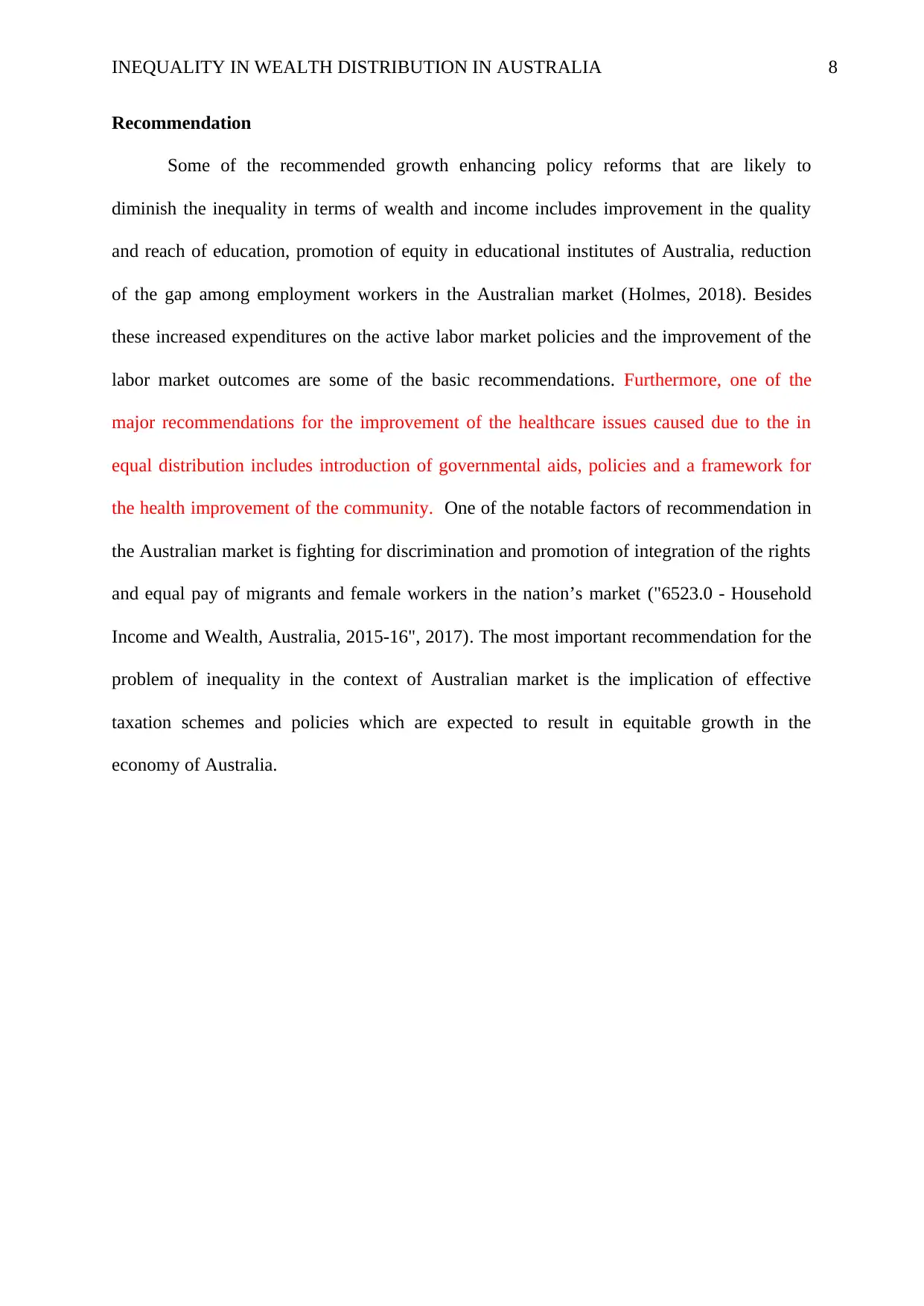
INEQUALITY IN WEALTH DISTRIBUTION IN AUSTRALIA 8
Recommendation
Some of the recommended growth enhancing policy reforms that are likely to
diminish the inequality in terms of wealth and income includes improvement in the quality
and reach of education, promotion of equity in educational institutes of Australia, reduction
of the gap among employment workers in the Australian market (Holmes, 2018). Besides
these increased expenditures on the active labor market policies and the improvement of the
labor market outcomes are some of the basic recommendations. Furthermore, one of the
major recommendations for the improvement of the healthcare issues caused due to the in
equal distribution includes introduction of governmental aids, policies and a framework for
the health improvement of the community. One of the notable factors of recommendation in
the Australian market is fighting for discrimination and promotion of integration of the rights
and equal pay of migrants and female workers in the nation’s market ("6523.0 - Household
Income and Wealth, Australia, 2015-16", 2017). The most important recommendation for the
problem of inequality in the context of Australian market is the implication of effective
taxation schemes and policies which are expected to result in equitable growth in the
economy of Australia.
Recommendation
Some of the recommended growth enhancing policy reforms that are likely to
diminish the inequality in terms of wealth and income includes improvement in the quality
and reach of education, promotion of equity in educational institutes of Australia, reduction
of the gap among employment workers in the Australian market (Holmes, 2018). Besides
these increased expenditures on the active labor market policies and the improvement of the
labor market outcomes are some of the basic recommendations. Furthermore, one of the
major recommendations for the improvement of the healthcare issues caused due to the in
equal distribution includes introduction of governmental aids, policies and a framework for
the health improvement of the community. One of the notable factors of recommendation in
the Australian market is fighting for discrimination and promotion of integration of the rights
and equal pay of migrants and female workers in the nation’s market ("6523.0 - Household
Income and Wealth, Australia, 2015-16", 2017). The most important recommendation for the
problem of inequality in the context of Australian market is the implication of effective
taxation schemes and policies which are expected to result in equitable growth in the
economy of Australia.
⊘ This is a preview!⊘
Do you want full access?
Subscribe today to unlock all pages.

Trusted by 1+ million students worldwide
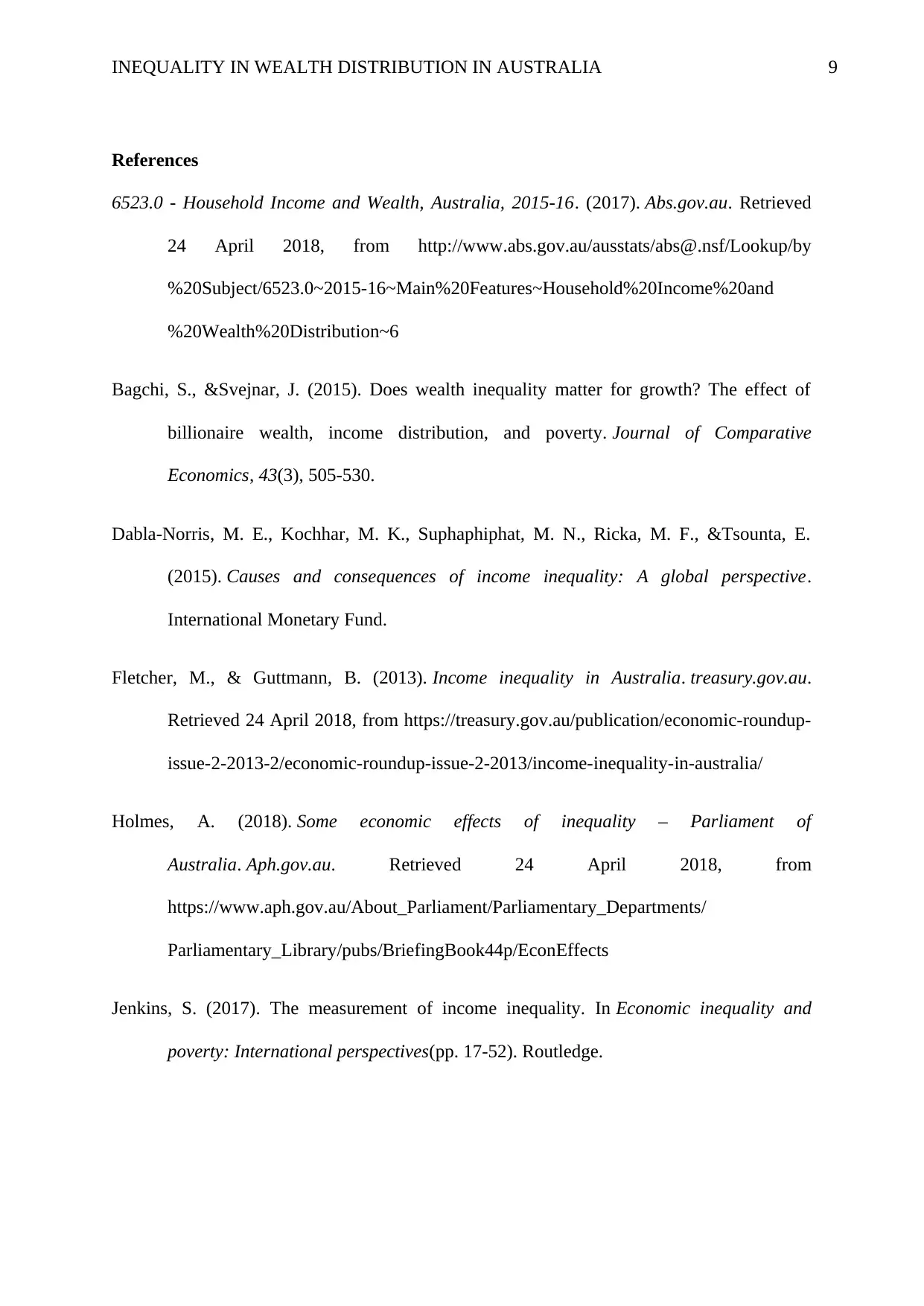
INEQUALITY IN WEALTH DISTRIBUTION IN AUSTRALIA 9
References
6523.0 - Household Income and Wealth, Australia, 2015-16. (2017). Abs.gov.au. Retrieved
24 April 2018, from http://www.abs.gov.au/ausstats/abs@.nsf/Lookup/by
%20Subject/6523.0~2015-16~Main%20Features~Household%20Income%20and
%20Wealth%20Distribution~6
Bagchi, S., &Svejnar, J. (2015). Does wealth inequality matter for growth? The effect of
billionaire wealth, income distribution, and poverty. Journal of Comparative
Economics, 43(3), 505-530.
Dabla-Norris, M. E., Kochhar, M. K., Suphaphiphat, M. N., Ricka, M. F., &Tsounta, E.
(2015). Causes and consequences of income inequality: A global perspective.
International Monetary Fund.
Fletcher, M., & Guttmann, B. (2013). Income inequality in Australia. treasury.gov.au.
Retrieved 24 April 2018, from https://treasury.gov.au/publication/economic-roundup-
issue-2-2013-2/economic-roundup-issue-2-2013/income-inequality-in-australia/
Holmes, A. (2018). Some economic effects of inequality – Parliament of
Australia. Aph.gov.au. Retrieved 24 April 2018, from
https://www.aph.gov.au/About_Parliament/Parliamentary_Departments/
Parliamentary_Library/pubs/BriefingBook44p/EconEffects
Jenkins, S. (2017). The measurement of income inequality. In Economic inequality and
poverty: International perspectives(pp. 17-52). Routledge.
References
6523.0 - Household Income and Wealth, Australia, 2015-16. (2017). Abs.gov.au. Retrieved
24 April 2018, from http://www.abs.gov.au/ausstats/abs@.nsf/Lookup/by
%20Subject/6523.0~2015-16~Main%20Features~Household%20Income%20and
%20Wealth%20Distribution~6
Bagchi, S., &Svejnar, J. (2015). Does wealth inequality matter for growth? The effect of
billionaire wealth, income distribution, and poverty. Journal of Comparative
Economics, 43(3), 505-530.
Dabla-Norris, M. E., Kochhar, M. K., Suphaphiphat, M. N., Ricka, M. F., &Tsounta, E.
(2015). Causes and consequences of income inequality: A global perspective.
International Monetary Fund.
Fletcher, M., & Guttmann, B. (2013). Income inequality in Australia. treasury.gov.au.
Retrieved 24 April 2018, from https://treasury.gov.au/publication/economic-roundup-
issue-2-2013-2/economic-roundup-issue-2-2013/income-inequality-in-australia/
Holmes, A. (2018). Some economic effects of inequality – Parliament of
Australia. Aph.gov.au. Retrieved 24 April 2018, from
https://www.aph.gov.au/About_Parliament/Parliamentary_Departments/
Parliamentary_Library/pubs/BriefingBook44p/EconEffects
Jenkins, S. (2017). The measurement of income inequality. In Economic inequality and
poverty: International perspectives(pp. 17-52). Routledge.
Paraphrase This Document
Need a fresh take? Get an instant paraphrase of this document with our AI Paraphraser
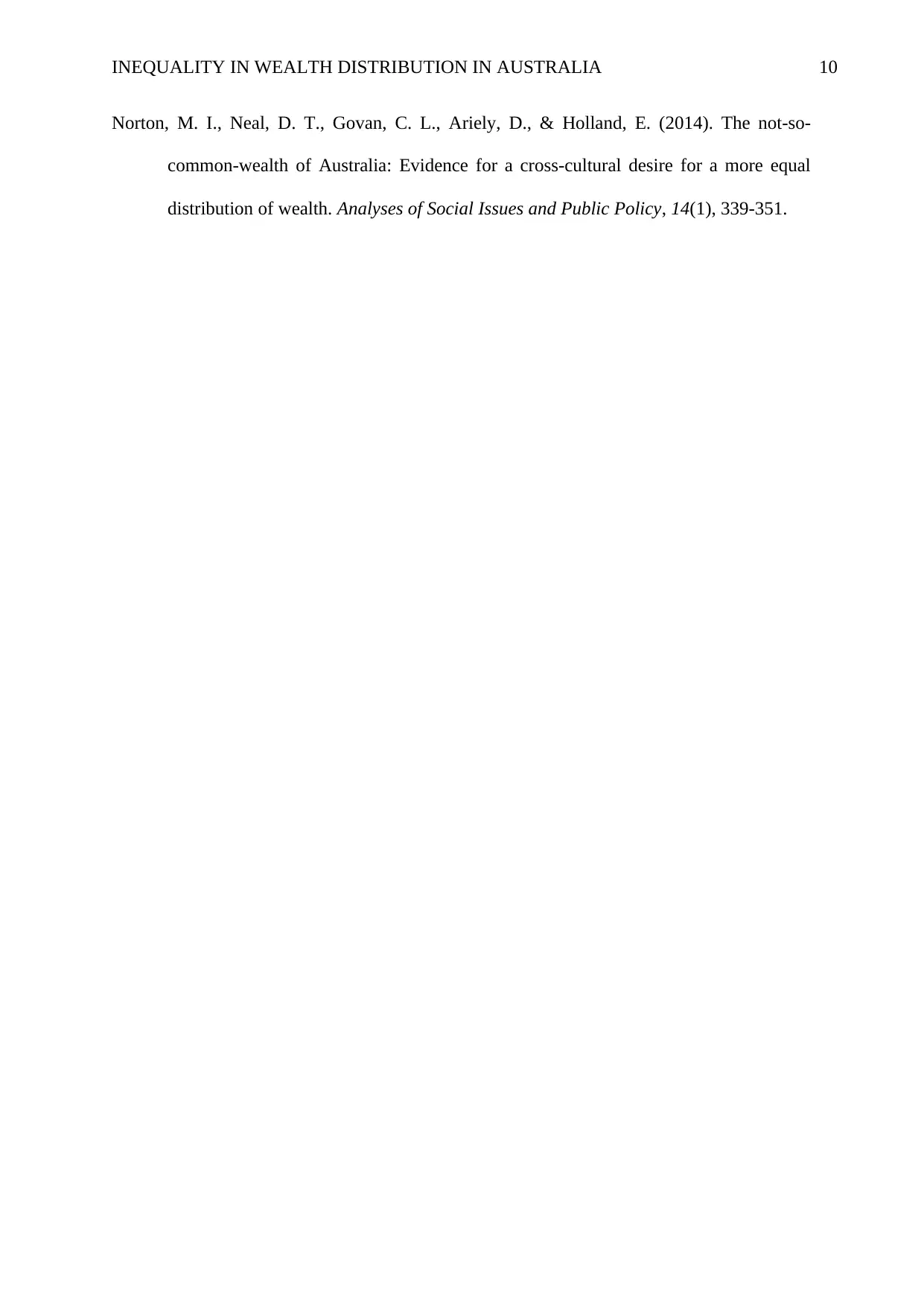
INEQUALITY IN WEALTH DISTRIBUTION IN AUSTRALIA 10
Norton, M. I., Neal, D. T., Govan, C. L., Ariely, D., & Holland, E. (2014). The not‐so‐
common‐wealth of Australia: Evidence for a cross‐cultural desire for a more equal
distribution of wealth. Analyses of Social Issues and Public Policy, 14(1), 339-351.
Norton, M. I., Neal, D. T., Govan, C. L., Ariely, D., & Holland, E. (2014). The not‐so‐
common‐wealth of Australia: Evidence for a cross‐cultural desire for a more equal
distribution of wealth. Analyses of Social Issues and Public Policy, 14(1), 339-351.
1 out of 11
Related Documents
Your All-in-One AI-Powered Toolkit for Academic Success.
+13062052269
info@desklib.com
Available 24*7 on WhatsApp / Email
![[object Object]](/_next/static/media/star-bottom.7253800d.svg)
Unlock your academic potential
Copyright © 2020–2025 A2Z Services. All Rights Reserved. Developed and managed by ZUCOL.




